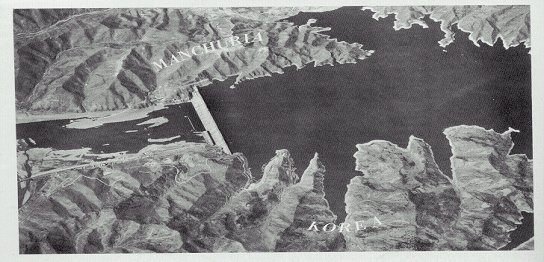Suiho - The Dam
Bud Farrell
In 1992, I inadvertently received a copy of the 17th Bomb Group Association Quarterly Newsletter, THE SORTIE, containing an article by Ted Baker, a Korean War B-26 Pilot, which referenced the Navy Fighter Bomber low level attack of June 24th , 1952, on the Suiho Hydroelectric Complex. It stated that the raid, and the subsequent B-29 raid of September 12th, 1952, had breached the great dam, then the fourth largest in the world, 60 feet wide at the top and 300 feet thick at the base, 349 feet high and 2,950 feet long across the Yalu River and forming a huge reservoir.
I wrote a letter to the 17th Bomb Group Association SORTIE editor correcting the minor inaccuracy of our attacking the dam , to advise that our target , that of the three FEAF (Far East Air Force) B-29 Groups, the 19th, 98th, and 307th, was NOT the dam but the power house and transformer yards at the base of the dam. My letter was forwarded to Ted Baker and has resulted in a continuing flow of phone calls and correspondence regarding this and other targets of mutual interest to the B-26 and B-29 Groups.
The Suiho Complex, constructed by the Japanese in 1940, had six of the world's largest turbine generators at 100,000 KW capacity EACH, surpassing those of Boulder Dam at 85,000 KW, and the reservoir storage capacity of 20 billion cubic meters of water was only slightly surpassed by America's Grand Coulee Dam. Suiho was THE major power source to Soviet Bases at Port Arthur China, and Darien China, and for the Russian Port of Vladivostok in Siberia, just 100 miles northeast of the northeastern most tip of North Korea.
The priority of this target had only been exceeded by its political sensitivity along with all the rest of the convoluted "logic" of Korea ... truce talks for three years while war flames on ... don't cross the Yalu after adversaries, the Migs out of Antung Manchuria, now proven to have been flown primarily by Russian, Czech, and Polish pilots, in addition to their Chinese and North Korean comrades. The one way route south for the Migs , with NO threat of retaliation, was particularly disturbing ... and deadly ... but the political sensitivity of Suiho as a target ( which TIME Magazine described as "sacrosant" in a 6/30/52 article) had withstood due to its value to Chinese/Manchurian and Russian industry and the shipping ports, until the frustration, futility, and desperation of the Fall 1952 campaign, with static front lines and no progress ... brought someone to their senses to discount the impact and concern over U.N. Allies , Indian and British relations ... and WENT FOR IT! The furor was soon to be heard ... a "shot heard round the world!"
On June 24th, 1952, a very large force of approximately 500 Carrier and South Korean land based Navy and Marine Fighter-Bombers attacked the power plant and transformer yards at the base of the dam, on the south side of theYalu, 2,950 feet or just about a half mile away from Manchuria. That attack knocked turbines and transformers out of commission, and pockmarked the vertical downstream face of the dam only slightly, no breaching was ever intended! Aerial reconnaissance showed that a few turbines and the transformer yard were up and running again by early September and now it was the turn of the FEAF Bomber Command B-29 force, with substantially greater bomb size ( up to 2,000 pounders) that might penetrate the hardened concrete roof of the power house and total bomb load capacity of up to 330 tons for the B-29 armada!
By now the defenses around Suiho had been heavily reinforced as THE key target of North Korea ... the key to reopen the doors at Panmunjom for the truce negotiators ... the KEY to getting the U.N. Allies out of the quagmire!
 Suiho Dam & Power Plant, Yalu River on Manchurian Border |